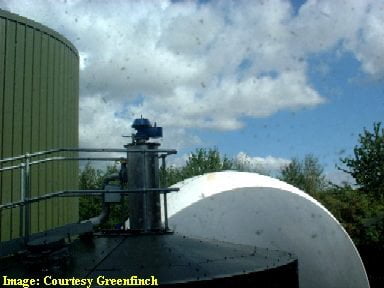
A growing interest in alternative energy and specifically, biogas and anaerobic digestion, is fuelling the construction of biogas digester facilities, which typically produce methane gas through bacteria-based anaerobic digestion (fermentation) of animal manure and other organic wastes.
Biogas and Anaerobic Digestion Facilities – Features and Safety
Biogas Digester: The Heart of the Anaerobic Digestion Process
The Biogas Digester is at the heart Anaerobic Digestion (AD) Process, and within the digester, fermentation takes place to produce methane gas (biogas), and a liquid and a solid fibrous “digestate” is produced as the residue after digestion has taken place, which is then removed from the digester.
Digesters are completely sealed vessels which are covered and sealed. Most are insulated and heated, and the digester is a recognisable feature at most large biogas plants as a large, tall, usually vertically sided, circular tank, with an access ladder and several pipes leading to the top, where there is also usually a pedestrian access way and handrail.
The above applies to the most common wastewater treatment works AD biogas digester plants, to agricultural installations (other than lagoon type plants), and the majority of low solids and liquid-phase high solids AD plants used for Municipal Solid Waste biogas production.
Biogas plant digesters of this type can usually be spotted very easily when you see them by the characteristic pairing of the digester with the biogas storage tank, which acts like a traditional town gas ‘gasometer’, and is usually elegantly curved or “globe” shaped. Many visibly expand and contract over periods of days, to accommodate the changing volume of biogas present. But it is their spherical shape which is most noticeable, making most of them landmark features wherever they are built.
There is such a wide range of biogas and anaerobic digestion process technologies, which contain biogas digesters, that there are many exceptions to the above rule, with some of these being as follows:-
- Low-cost and usually quite small on-farm/agricultural biogas digesters are designed around a covered lagoon that is lined with a plastic membrane (usually polyethylene), and this membrane is simply welded to the flexible membrane cover. The cover balloons upward under the pressure of the biogas generated, and this allows it to be stored.
- High solids density processes may include a biogas digester, which works in so-called “plug flow” in long tunnels. These vary in design according to the technology provider’s patent process, and Dranco, and Schmack are companies which provide design options for digesters of this type.
- Water treatment (biogas producing) digesters may be quite different, and for optimum stability of an Upflow Anaerobic Sludge Blanket (UASB) digester, an upturned cone shape (with the apex at the bottom) works best. However, ArrowBio’s UASB digestion tank does no such thing and looks like any ordinary vertical-sided biogas digester.
- Small and community-scale biogas (sewage and night soil) digesters, as used in China and elsewhere, tend to be buried and fed by gravity. Again, the gas is usually stored in these very simple plants above the digester itself, and the storage space may itself be considered to be part of the “digester”.
Within a biogas digester, where the biomass will usually be present on average for between 4 days and 3 weeks, according to the process requirements, heating and mixing take place.
Some digesters are mixed mechanically with blades which turn, while others avoid the presence of mechanical parts in the digester, which are hard to maintain, by pumping.
The action of mixing and heating with the digester allows the bacteria in biogas and anaerobic digestion plants, within the digester, to come into contact with the feedstock material, which provides food for the bacteria to multiple and convert the complex organic compounds into much simpler mostly soluble compounds such as sugars and starches, which then react in further stages resulting in methane gas which comprises about 60% of biogas.



You say that within a biogas digester, the biomass will usually be present on average for between 4 days and 3 weeks. Please give a closer time. I seek this from you.
If you are looking to live a more green and eco friendly life, try a micro hydropower system. These devices will use the current running water in your home through a turbine to produce energy, which is both renewable and better for the environment. Try this alternative if you’re looking to reduce your dependence on fossil fuels.
This overlooks the potential challenges and costs associated with installing and maintaining sight glasses for continuous observation. How long do you really think they stay clean?